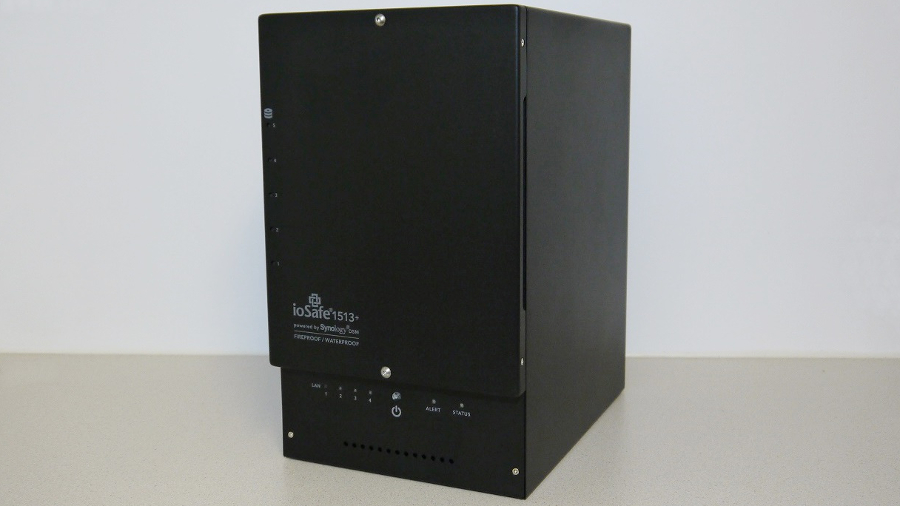TechRadar Verdict
Those who really value their data may well think the high price of this disaster-proof ioSafe NAS is worth paying.
Pros
- +
Based on trusted Synology NAS technology
- +
Protects data against fire, flood and theft
- +
30TB capacity expandable up to 90TB
Cons
- -
Only the disks are protected from disaster
- -
Expensive compared to Synology original
- -
Noisy fans
Why you can trust TechRadar
Using a network attached storage (NAS) appliance to share data is akin to putting all your eggs in one basket – it's great for collaboration, but a single point of failure vulnerable to all manner of risks. Fortunately, most of these risks can be mitigated against.
Disk failure, for example, can be handled by RAID and if the worst comes to the worst a recent backup will see you through most other disasters. For the ultimate in protection, however, there's also the ioSafe, a ruggedised NAS inside a fireproof and waterproof casing resistant to temperatures of over 840 degrees Celsius (1550 Fahrenheit) and immersion in fresh or salt water to a depth of 3 metres (10 feet) for up to three days.
With prices starting at around £2,950 excluding VAT (around $4,620, or AU$5,295) for 10TB of capacity it's far from cheap, but for companies with business-critical data to protect the premium involved could well be worth it.
Synology by any other name
Literally, the biggest member of the ioSafe family, the 1513+ is a five-bay appliance based, unsurprisingly, on the Synology DiskStation of the same name – the DS1513+. That means it sports a 2.13GHz dual-core Intel Atom processor supported by 2GB of DDR3 RAM (upgradeable to 4GB) plus four USB 2.0, two USB 3.0 and two eSATA ports, all of which can be used to attach external disks, either for expansion purposes or to take backups.
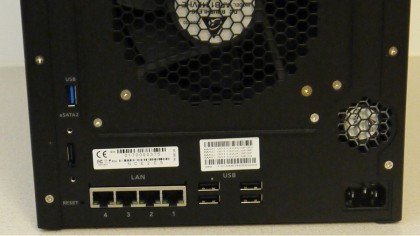
Just as on a Synology appliance the ports are all located round at the back along with a four Gigabit switch for network attachment, two huge and somewhat noisy cooling fans and a built-in mains power supply. Indeed, apart from an ioSafe branded management interface the NAS side of things is all Synology. However, instead of a desktop enclosure you can happily pick up and move around, the ioSafe is absolutely massive, calling for two people just to unbox it.
Size matters
For a NAS the ioSafe really is big, about the size of a tower server, and incredibly well built inside a heavy gauge steel casing that stands some 375mm high, 222mm wide and 318mm deep (14.75-inch x 8.75-inch x 12.5-inch). It's also very heavy, weighing in at a hernia-inducing 27kg (around 59lb) including disks. That's over six times the weight of the Synology original with the extra bulk accounted for by all the metal and fireproofing material protecting the drives.
And that's an important consideration as it is only the drives that are protected. The fans are open to the elements and there's no waterproofing of the ports or AC connection, so drop the ioSafe into a (large) bucket of water for example, or set fire to it and it will stop working, just like any other NAS, although your data should survive.
Sign up to the TechRadar Pro newsletter to get all the top news, opinion, features and guidance your business needs to succeed!
That's because the disk bays are safely tucked away deep inside the casing, protected by an insulated metal panel, and then once that's removed, a waterproof door. Access calls for the use of a large Allen key that comes with a magnet to attach it to the case. This is used to both remove the doors and release the slide-in metal carriers that hold the disks.
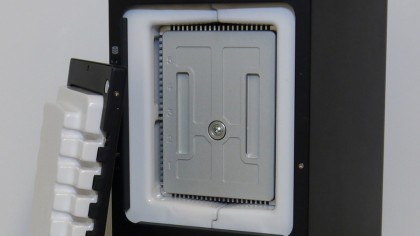
The disks themselves are ordinary 3.5-inch or 2.5-inch SATA drives, in theory giving the ioSafe a capacity of up to 30TB using the latest 6TB disks. Optional disaster-proofed expansion units can also be attached via eSATA, taking overall capacity to a massive 90TB altogether. There's also support for hot-swapping, but it does take several minutes to gain access to achieve this.
Theft protection is limited to a rather puny Kensington lock fitting as standard. However, the weight of the unit alone is likely to deter most potential thieves while, for the paranoid, a kit is available to bolt the ioSafe to the floor and lock out access to the ports.
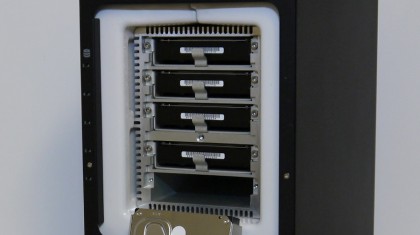
Setup
Setup is exactly the same as for the standard Synology DiskStation, with the DSM operating system installed via the cloud rather than CD-ROM, and easy to expand Synology Hybrid RAID (SHR) technology employed by default, although standard RAID levels can be used instead. The same NAS sharing options and iSCSI capabilities are also to hand and you can install all the same apps to run on the ioSafe including web, email, database and surveillance servers.
Performance
Capacity and performance will depend on setup. The ioSafe appliance is sold with disks already inside, our 10TB test unit shipping with a set of five 2TB Toshiba 7,200rpm disks, giving us 7.2TB of usable capacity when delivered through a single SHR volume.
Using the ATTO disk benchmark the ioSafe was able to fully exploit the bandwidth provided by a single Gigabit connection to our test client, recording throughput rates of around 117MB/sec both reading and writing data.
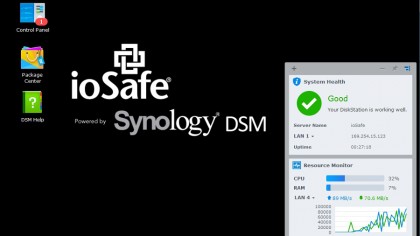
One way of increasing this would be to use all four Gigabit ports together with port aggregation. However, a compatible switch is required for this option and the gain isn't always as big as might be expected. Most customers are likely, therefore, to use VLAN technology to assign individual workgroups to specific ports on the appliance and share the aggregate bandwidth that way.
Unfortunately we weren't allowed to put the fire and flood claims to the test, but others have and there's little doubt that ioSafe can come through such incidents with data intact. You also get a 12 month warranty that includes a subscription to ioSafe's Data Recovery Service (DRS Pro) giving you cover for up to $5,000 per TB (around £3,200, AU$5,700) to forensically recover data following an incident.
